
Interview with Leo Kokkonen
Behind Pole's CNC 'Superbike' - The Machine
Finnish bike company, Pole Bicycles made some notable headlines in the latter half of 2017 with news first breaking about scrapping the carbon frame thanks in part to environmental reasons. Then followed news of the company's CNC manufactured frame, the Machine. Before we dive into the discussion on the new frame and how it came to be let’s back up a little and delve into the company's background.
Meet Leo Kokkonen, an Industrial Designer, DJ, previous international Judo competitor, and perhaps most importantly, a rider. While today Leo is a passionate rider, that part of the story took longer to build. At sixteen Leo saved enough money delivering papers to purchase his first mountain bike and at the time he was busy participating in Judo competitions around the globe. Riding his bike brought him and his friends great joy, but for Leo, it remained secondary to his martial art. For years cycling remained something he did for fun with friends.

Leo Kokkonen, the designer of the Machine, races DH at the pro level. (this however is not Leo)
After a stint in the army, Leo enrolled in school to become an Industrial Designer, working as a DJ to make some money. In 2004, straight out of school, he founded his Industrial Design company and was happy to be making enough money to buy some better-equipped bikes. When Leo lost his drivers license in 2008 he decided a new bike was in order, and this is where the hobby took a drastic turn.
Leo purchased a downhill bike and immediately began racing DH. He found his passion for mountain bikes riding dh and it took over his life. Ever since he has spent all of his free time on mountain bikes. Through his Industrial Design company, Leo was already working on a number of projects for other brands covering the gamut of product development, marketing and user interface ideas. With the experience and services that he was offering and a strong sense that trail bikes weren’t as good as they could be, he felt it was possible to do it all for himself and in 2013 he founded Pole Bicycles. Sales began in 2014 and the Evolink range of bikes first hit in 2016.
Leo has since removed himself from any other companies that he was a part of and is solely focused on working with the mountain bike brands that he is involved in; Pole and Huck Norris.
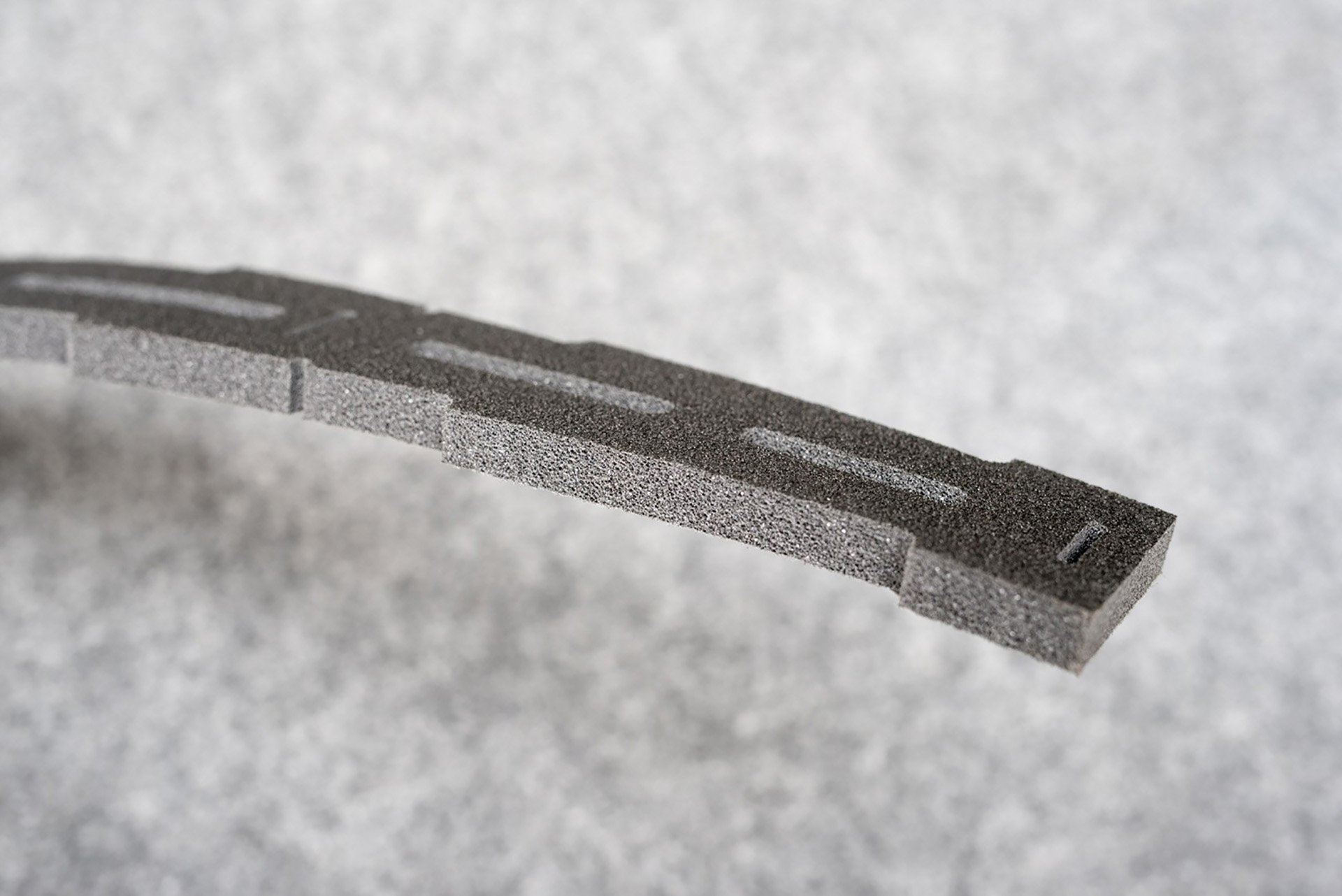
Leo is part of the team behind the Huck Norris flat tire prevention system.
The Machine
The Pole Machine is a 160mm travel 29er built with a focus on aggressive downhill riding but with climbing capabilities. The team at Pole claim to have worked on a number of key features with the new bike, including; low standover height, lots of tire clearance with room for 3” 29er treads, three bottle mounting locations, clean external cable routing and the use of an asymmetric shock mount for greater clearance and longer seat tube insertion.
The bike features a unique/radical geometry, sporting a 63.9-degree head angle and a 79-degree (effective) seat tube angle coupled with long 455mm chainstays. Pole use similar concepts to Chris Porter’s GeoMetron, distributing rider weight more central between the wheelbase. Add the CNC manufacturing process to the unique geometry and the result is one of the most distinct bikes, ever.
Pole Machine Geometry
| Rider size: | 160–170cm | 170–180cm | 180–190cm | 190–200cm |
|---|---|---|---|---|
| Frame size: | Small | Medium | Large | Extra Large |
| Head Angle: | 63.9º (591mm AC, 51mm offset) | |||
| Reach: | 450mm | 480mm | 510mm | 535mm |
| Top Tube: | 577mm | 607mm | 637mm | 662mm |
| BB Drop: | -20mm | |||
| Seat Tube Angle: | 78º | |||
| Seat Tube Angle (Effective): | 79º | |||
| Stack: | 660mm | |||
| Wheelbase: | 1275mm | 1305mm | 1335mm | 1360mm |
| Chainstay Length (Effective): | 455mm | |||
| Seat Tube Length: | 420mm | 440mm | 480mm | 510mm |
| Head Tube Length: | 135mm | |||
| Fork Offset: | 46–51mm | |||
| Front Center: | 820mm | 850mm | 880mm | 905mm |
| Standover (BB to Lower Portion of TT): | 360mm | |||
| Seat Tube Insert Length: | 190mm | 210mm | 260mm | 290mm |
| Seat Tube Diameter: | 30.9mm | |||
| Seat Tube Clamp: | 34.9mm | |||
| Axle to Crown: | 581–591mm | |||
| Brake Mount: | Direct mount | |||
| Travel Front: | 170–180mm | |||
| Travel Rear: | 160mm | |||
| Shock Size: | 230x65mm | |||
| Bottom Bracket: | 73mm threaded | |||
| Chain Device: | Low direct mount/Pole bashguard | |||
| Bottle Mounts: | Three (two on top and one beneath downtube) | |||
| Dropouts: | 148mm | |||
| Axle: | 180mm, thread length 20mm, thread pitch M12x1.75 | |||
| Wheels: | 27.5+/29" 730–755mm | |||
| Recommended Max Tire Size: | 3" (27.5"), 2.8" (29") | |||
| Tire Clearance: | 91mm (sideways), 384mm (from axle), 11mm to seat tube (29", 3") | |||
| Shifting: | One-by only, 36t max | |||
| Cable Routing: | External/Stealth Dropper Post | |||
| Recommended Shock: | RockShox Super Deluxe L1/M | |||
| Material: | 7075 T6 Aluminium | |||
| Weight: | 3kg (Size M including hardware w/o shock | |||
| Colours: | Machined Raw | |||
I caught up with Leo after he got back from a December riding trip to Spain, briefly escaping Finland’s winter months. We discussed how the Machine came to be, the process of manufacturing a bike frame from CNC aluminum, and what happened to the carbon bike.
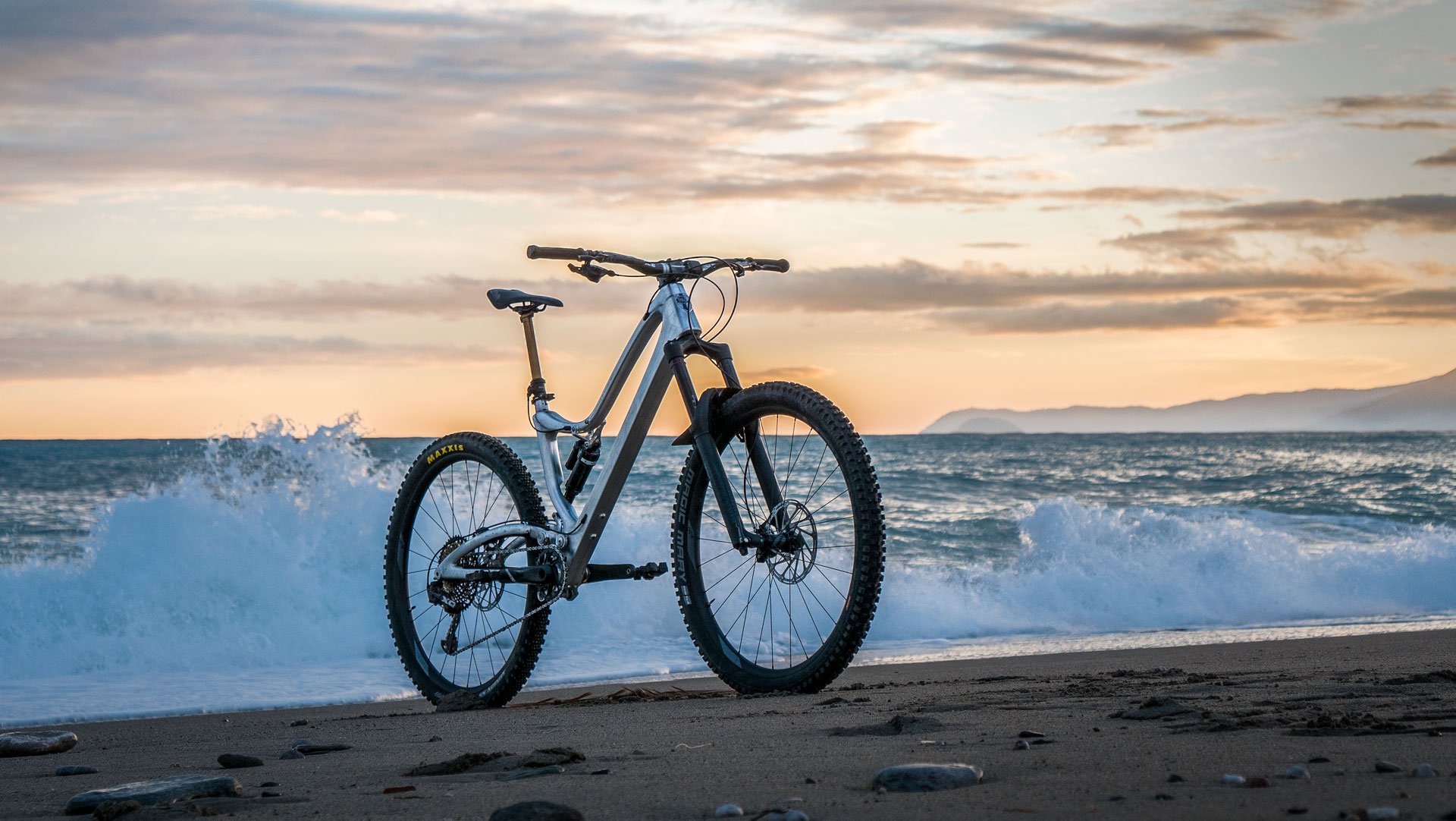
Interview with Pole's Leo Kokkonen
So Leo, when did the planning process for the Machine begin and what was the goal for the bike?
We ditched the carbon frame project in January 2017 and started to look for an alternative method. We want to produce bikes that are extraordinary in performance and durability. With the Machine, we wanted to create something beautiful as well. I believe that beauty is something when the product works perfectly and there is nothing to be taken away from the design.
We performed lots of research which involved working with universities. The idea to CNC came through collaborations with some manufacturers here in Finland. I personally think it's a really cool idea. It's basically rapid manufacturing. People think that only printing is considered as rapid manufacturing. There are CNC-machines that are removing and adding material, though we only use the machines that remove material.
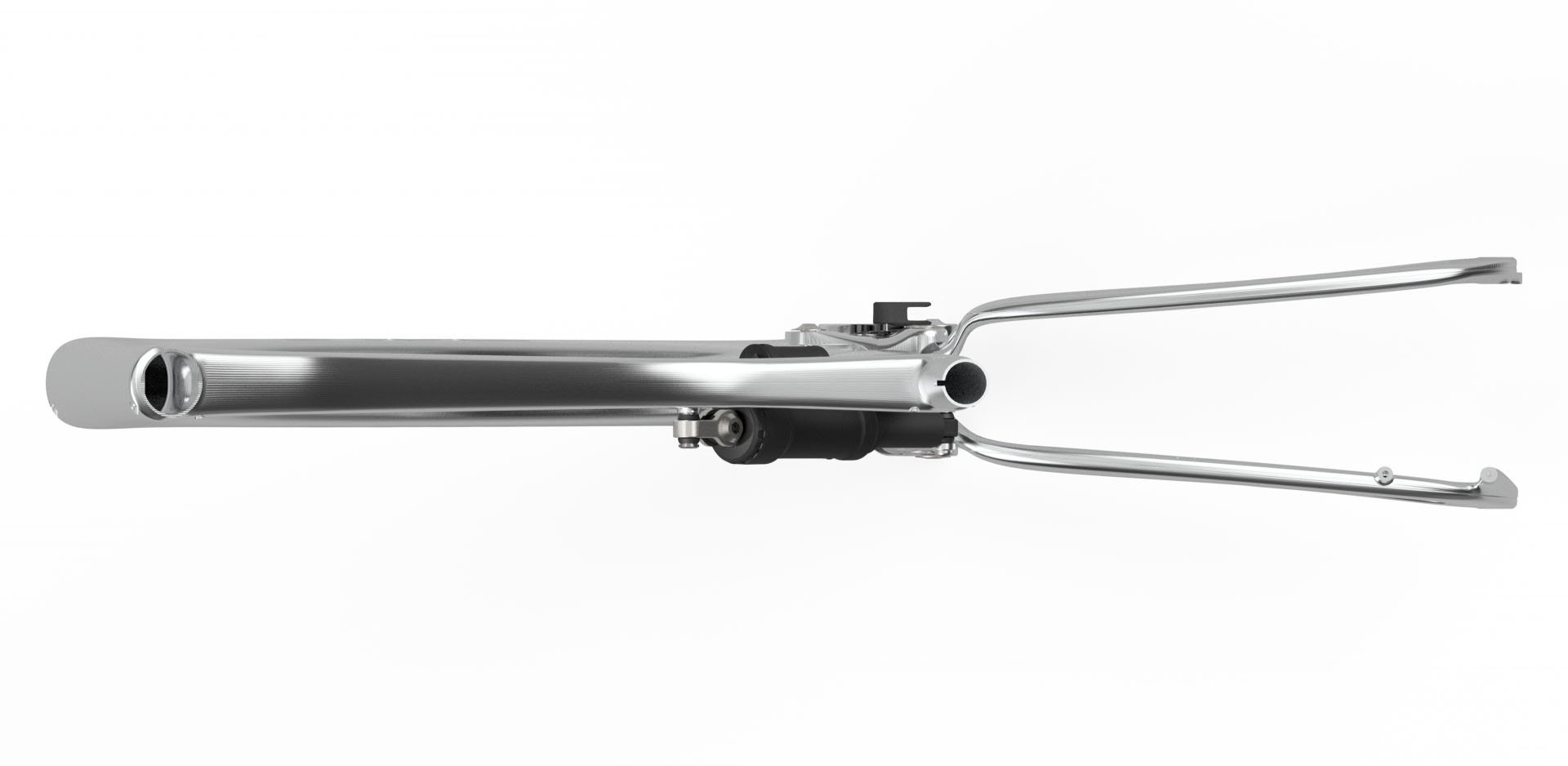
Go big. There is clearance for up to 27.5 x 3.0" or 29 x 2.8" tires.
We heard about the problems that you had with carbon manufacturing. The Machine appears to be quite different from the mule for the carbon, how did changing the material affect the design?
We never went carbon so basically there were no problems. We saw the carbon manufacturing as a big lump of problems. Making bicycle frames in poor countries and taking advantage of their bad regulations is not a very good idea. It often backfires, resulting in low quality, bad waste disposal, and low wages. Mountain biking at the high end is grown-ups playing with expensive toys after all. Why couldn't we make it fair play. As a small company we didn’t see any possibilities to change things in the Far East so we started to rethink the manufacturing as well.
The model in the video we released was a 3D printed plastic mock up. We cancelled the project when we discovered the problems with the production quality, labor, and environmental issues. Changing material always changes some details. Basically I needed to make the 3D model from the ground up. The bike’s dynamics are the same as in the first concept.
Making bikes longer every year sounds like corporatism, doesn’t it? Pole is a concept of a bike that rides fast, easier. The concept is designed from a clean sheet of paper and unless we learn something radically new we don't change the concept. We experimented with geometry quite a lot when we designed the Evolink and found a good balance between the suspension dynamics, stiffness, and the geometry. Our first concepts were single pivots with BB-concentric swing-arms and we rode them faster than many bikes with a lot of anti-squat. In the process, we learned much about suspension and the kinematics. We have a recipe on how to make a bike ride fast and it’s not only the geometry that is involved in the mixture.
For example, if we change the anti-squat, it will affect the rider (pushes the weight forward on impacts) so we need to change the suspension and head angle as well. When I design a bike, I think about every detail of the bike design at the same time. I myself am responsible for the whole bike’s engineering, from kinematics to the industrial design. I use simulation software to analyze the frame stiffness and AI to reduce weight but I cannot use a computer to give me a concept for a bike. The concept has to come out of the engineer’s head.
It's important that the designer of the bike can push the bike to the limits so he can know what he's doing. Knowing about riding fast helps the engineer in communicating with the professional riders as well. Not every engineer is a pro downhill racer so it's a bit hard to transfer the information from the racers to the engineers and vice versa. I see corporations using a lot of equipment to analyze the bike's behaviour but still, they end up doing everything pretty much the same way they used to make the bike. I see that we have more possibilities for a new design when we don't follow the market research. When I ride the bike, I can feel what I did. Every time I go ride I learn something new from our bike.
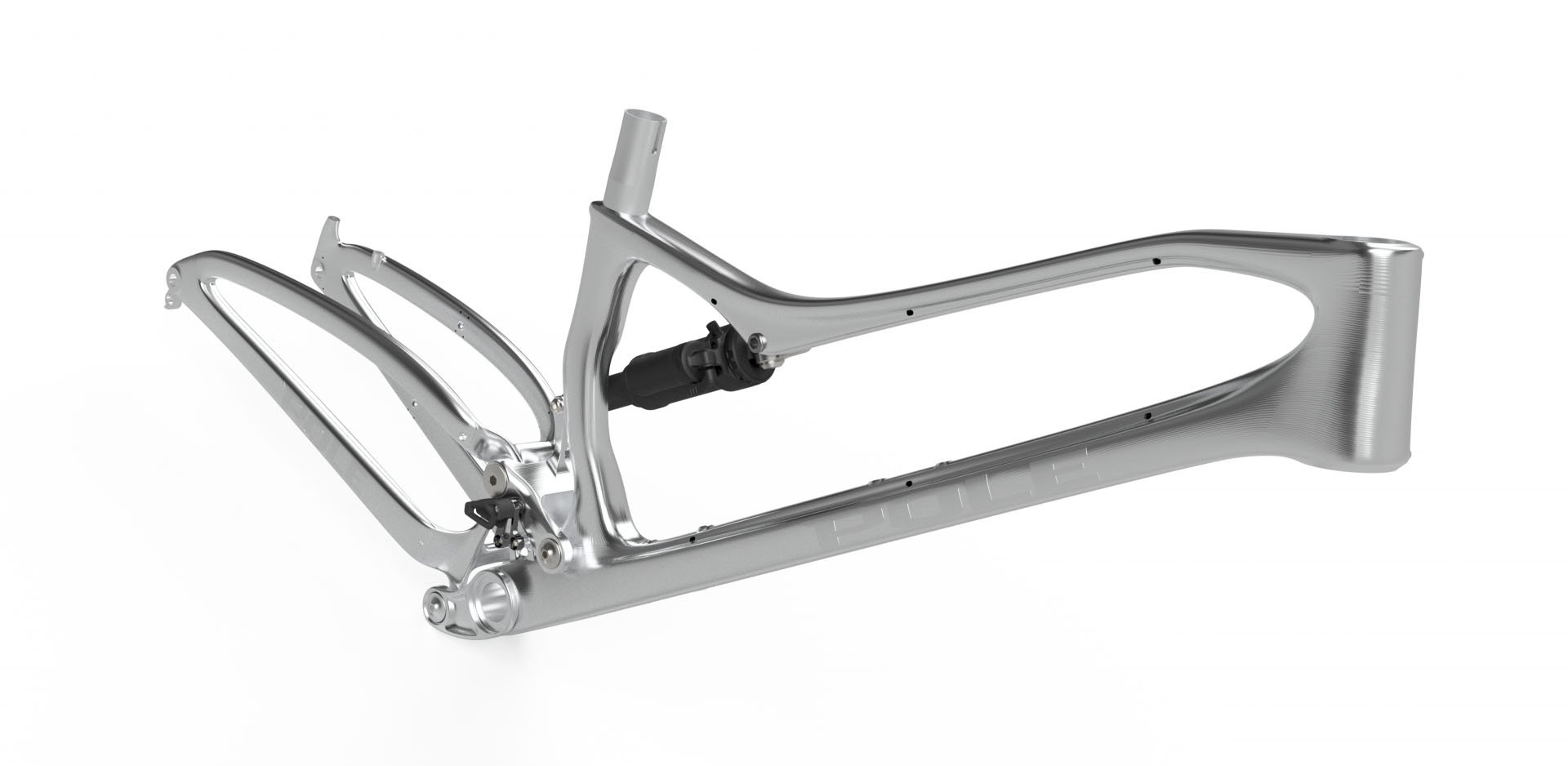
Three bottle cage mounts.
Why did you move from the more conventional 6061 alloy to 7075 for the Machine? Was it purely because of the manufacturing process or were there other aspects at stake?
7075 T6 is 80% stronger than 6061 T6, therefore, we can make much lighter and stiffer bikes.
So if the move in material was purely to make a stronger, lighter bike, why not make a regular tubed/welded frame?
Because 7075 aluminum cannot be welded.

Cable routing is external but incredibly sleek.
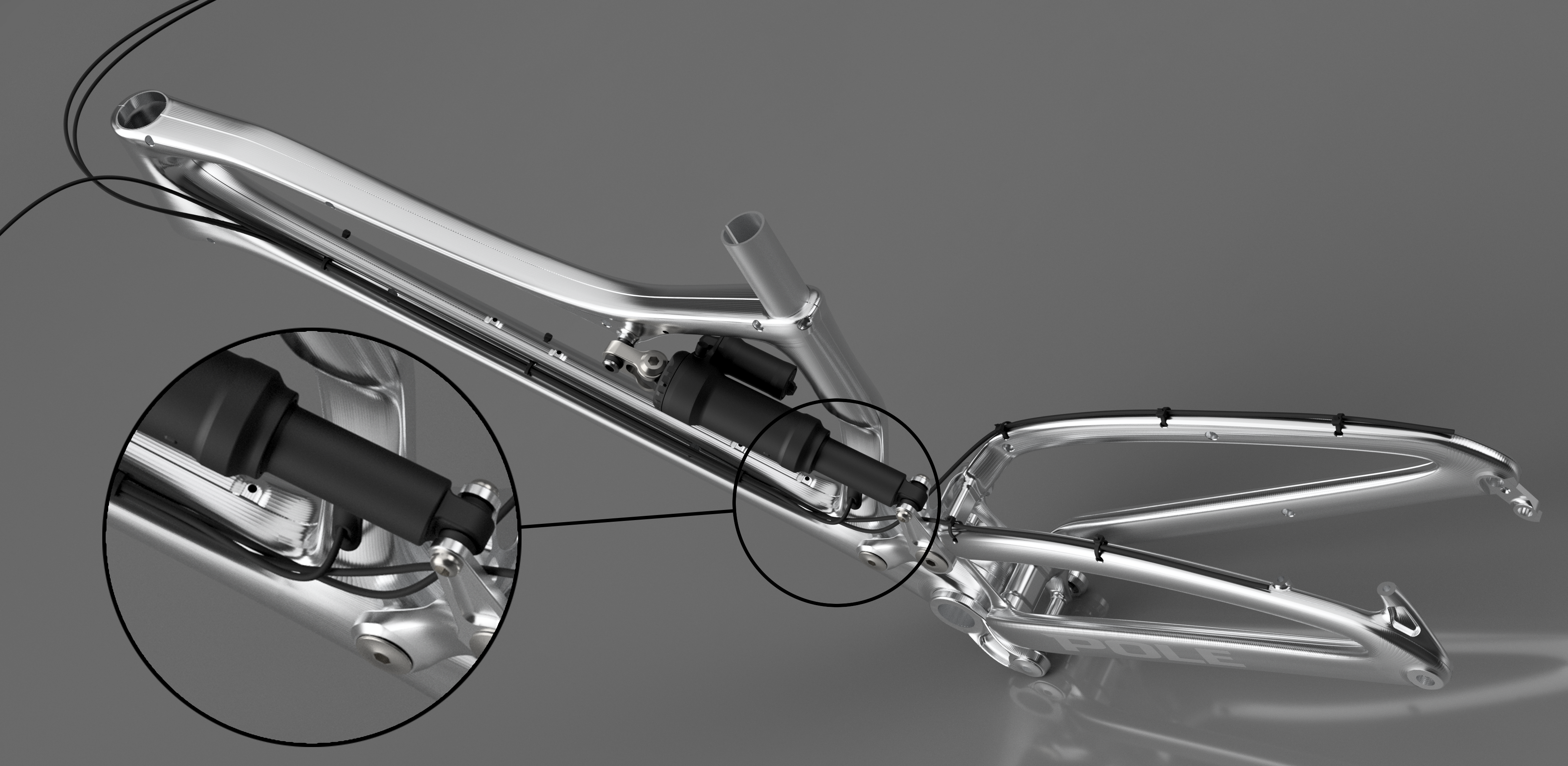
The asymmetric shock provides more clearance. Pole has also improved cable routing on the CNC bike.
The biggest challenge was that I needed to reinvent the 3D modelling of the frame. I needed to learn several new CAD programs in order to do this. Nobody is making this kind of product so the tools in CAD programs are not very ideal to multi-piece-variable-wall-thickness-tubular-shell design. Now I can control the wall thickness throughout the model and we can create extraordinary structures that are not possible with conventional manufacturing methods. Other than that we are solving more problems with this design than creating them.
7075 T6 aluminum is a fairly coherent material. Compared to carbon fibre it’s much easier to control and design. A high-end mountain bike is a very complex product because it needs to be light, stiff, durable, and it cannot break under impacts. Also, everyone seems to ride it differently. Airplanes are much more simple when it comes to this. There are no computer programs, so you cannot calculate, exact flex or stiffness of a carbon fibre mountain bike. You just need to experiment and find the best solution and still, you might not get the best result.
With aluminum, we just need to add material and adjust the shape to get better stiffness. The 7075 T6 is maybe the best compromise so far when we look at high-end mountain bikes for stiffness, strength, and penetration resistance. We control the wall thickness of the frame and can make internal shapes that are not possible with any other method. We can use some other materials inside the frame as well. Machining removes six phases from the hydro-formed and welded frame's manufacturing process and it's possible to fully automate the manufacturing of the Machine. The bonding is quite a normal process in the aircraft industry so the knowledge is easily accessible for us. The whole process can be done in weeks rather than months and we don't need to guess which size, colour and model people are interested in. We make everything from natural demand.
I often get this question. The same question could be asked about the Huck Norris (Ed: another concept/brand that Leo is behind). Why had nobody invented such a simple system before? I think this is more of a philosophical question. I guess when the world comes to a point when something is possible, people start inventing things around it. This year there have been many new bicycle companies. In our case, the reason we ended up this way might be the collaboration between Finnish education, globalism, markets etc. that created the need for these kinds of activities for us and it all bursts out through our desire to make mountain bikes. I think that the Machine is the kind of hubris that we tend to do as humans when we want to take something to the ultimate level.
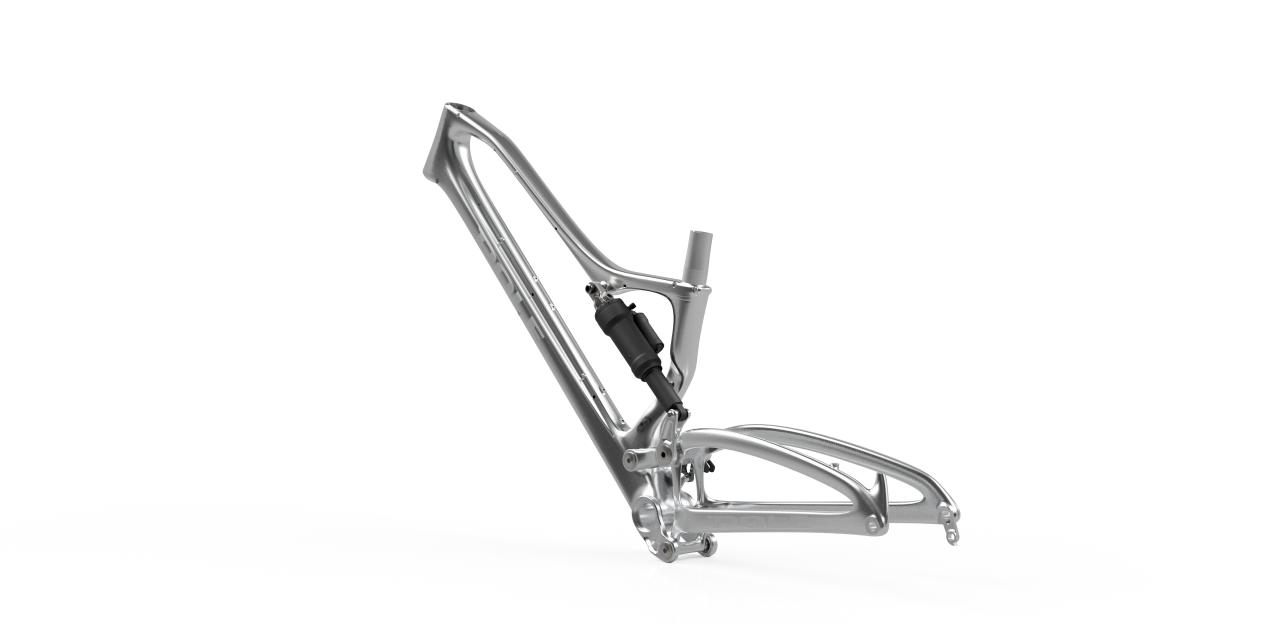
The Machine continues to utilize Pole's Evolink suspension but the frame is said to be lighter and more positive feeling on the trail thanks to the CNC 7075 T6 aluminum frame.
What characteristics can riders expect on the trail as a result of the 7075 T6 AL and the build process and how would it differ from the bike being built from 6061 T6 alloy?
The Machine is the next level from our Evolinks. The Evolink’s performance comes from all the things explained before but the 7005 T6 aluminum that we use on the Evolink is not even nearly as strong as the 7075 T6. The advantage of the 7075 T6 to a 6061 T6 is that we can actually make a lightweight frame without the spaghetti effect that the über light 6061 T6 has. Also, it's harder to dent the 7075 T6 frame. My first impression of the bike was just big, “WOW”.
There is more travel and it’s more fine-tuned than the previous trail bikes. The Machine might be the first superbike. By superbike, I mean that this bike is very close to a downhill bike’s abilities but still may be pedalled uphill and ridden on normal trails. The Machine has a bit more progression to the shock than our Evolinks because the Super Deluxe air shock characteristics are closer to coil shocks. I feel that the Machine's suspension is close to perfect as it can be at the time. When I watch the videos when someone rides the Machine, I see immediately that the bike’s platform is efficient and stable.
The front and rear triangle are each built utilizing a series of different machined pieces that are glued together; how is it possible for the glue to hold everything together and how does this process affect ride characteristics?
The details to our frame structure and the bonding process are a trade secret at the moment. The adhesives that we use to bond the frame parts together are high technology materials based on science. We machine the parts (three for the front triangle and seven for the rear) and then they are bonded together with special adhesive. The screws that are used instead of jigs to press the pieces together on the frame could be removed but we let them stay for precaution. The bonding process does not really affect the ride, it’s the 7075 T6 material, the shape (internals as well) of the bike and the bike dynamics altogether.
What is the average weight of the Machine frame and shock? What do you expect the weight range of complete bikes to be?
The weight of the medium frame is about 3.2kg without the shock and the complete Machine EN is around 13.5 kg. We don’t know for sure yet and this might change throughout the lifetime of the product as we can improve the design all the time. It might not chance as well… we don't know.
We sell customer direct and the pre-orders are open. All bikes are paid first and delivered after. If someone doesn't want the bike, after all, they can cancel the purchase at any time before the shipment but then they lose the machining slot. All bikes are made from orders and we don't keep stock. The delivery time is still not fixed but it's weeks. Our policy is that we try to serve our customers as good as possible. For example, some people wanted to change their pre-ordered Evolink to Machine. We just charge the difference. We also buy back used Evolinks when our customers want to purchase a new Pole.
For more info on The Machine and Pole Bicycles click here...





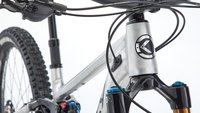

Comments
another_waki
6 years, 3 months ago
Wow, what a balanced and informative interview. I enjoyed reading it. Good luck Leo, just stay away from Pinkbike and it’s click generating drama. Sorry for overreacting in the past for your over blown enviro concerns. After all we all ride bikes for fun.
Reply
Leo Kokkonen
6 years, 3 months ago
No problem :)
Reply
mike
6 years, 3 months ago
as a machinist this is pure PORN!!! and I love the idea
Reply
AJ Barlas
6 years, 3 months ago
hashtagmachinistporn
Reply
Endur-Bro
6 years, 3 months ago
Metal is the new carbon!
Reply
Merwinn
6 years, 3 months ago
"So if the move in material was purely to make a stronger, lighter bike, why not make a regular tubed/welded frame? "
" Because 7075 aluminum cannot be welded."
FYI...
" In the vast majority of , it is a very poor and possibly even dangerous practice to weld 7075 or 2024. The problem is that these two and similar alloys are extremely prone to microcracking, which is not always easily detectable and can lead to catastrophic failure while in service. For this reason, you will never find a recommended filler metal for welding 7075 or 2024 in any manufacturer’s literature."
https://www.thefabricator.com/article/aluminumwelding/aluminum-workshop-what-s-so-bad-about-welding-7075-2024-
Reply
AJ Barlas
6 years, 3 months ago
Thanks a lot for the additional snippet on 7075, Merwinn.
Reply
Skyler
6 years, 3 months ago
Really great interview. Leo Kokkonen is clearly brilliant.
Reply
Nouseforaname
6 years, 3 months ago
Really? I got kind of turned off by him TBH.
I like the ideas, maybe it was just something lost in translation/ESL. He is certainly very keen on what Pole does, and I guess Mike Sinyard is equally stoked on the smell of his own farts too.
Reply
T-mack
6 years, 3 months ago
Ok here are my thoughts on this bike. Regarding the whole 'recyclable' issue I have to make a point. Yes alu can be recycled into more frames or pop cans etc HOWEVER processing alu comes with its own challenges and environmental impact. Carbon can't be recycled which is true HOWEVER good quality carbon should never have to be (shameless We Are One plug here). I can see there being an issue with these 'disposable' Alibaba frames from China yes, but good carbon products should be useable for a long ass time, longer than alu if made properly. I had a carbon Marin frame that went through rear ends every month. it got to the point where I literally had a whole shelf piled with rear triangles. Theres a huge difference between that frame and a high end Santa Cruz frame for example. Leo's decision to go alu is probably not a gimmick as he knew he was going to get a low quality frame.
Now is there going to be a method to recycle carbon in the future? Of course there will be so it's a non issue IMO. That being said, as a machinist, I freaking love this frame! As a proud owner of an Evolink I also have to say that the customer service is amazing as well. Every email I sent was responded to in hours and that was enough to get my credit card number. Yes the frame is new and interesting but I wouldn't worry when it came to plunking down the cash. There's nothing wrong with a new and interesting way to build a bike, look at Robot and the 3D printed bike wihch is badass imo. If the company is willing to stand behind their product then who cares, get the exciting new bike and enjoy it, afterall thats what biking is all about right?
Reply
jaydubmah
6 years, 3 months ago
@T-Mack: I would have to echo your sentiments on Pole's customer service. Every email I sent them, I got timely candid replies - and ditto, they won my business. When it came to pricing, it wasn't much more than boutique frames from Santa Cruz , etc and I'm willing to take the risk and support something from a small player doing something innovative.
Coming from a mechanical engineering background, I can appreciate (or nerd out) on tons of the design elements here. Material finish and hardness, the multiple bottle mounts, super modern geo, creative shock mount approach, etc.
From a shock-mount perspective, it's no different than how a wheel is mounted to a Cannondale Lefty fork. I'm not a fan of the Lefty, but I've never heard of a hub / fork interface issue. As for swingarm replacement, etc - it's probably on the same order of cost as carbon, and Pole's customer service seems legit.
After my last few bikes being incrementally better than the prior one, I'm keen to check out a brave leap forward on design and execution.
Reply
Peter Leeds
6 years, 3 months ago
Your comparison to the Lefty is not accurate. The Lefty is an axle, which although faces the same stresses and shear forces the axle is MUCH large and thus can take much more force. The screw that mounts the shock on the front triangle is experiencing the force of the shock in exactly the worst way possible; it will either bend, crack or break over time, assuming the bike would be ridden to experience "reasonable forces". This does not mean drops to flat over and over, of course. There is a reason most bikes have the shock mounted such that the bolts go through and are braced on both sides.
Like I have said, nice bike but I can't see it being for more than light trail riding. And although you may find that Pole's CS is excellent, fixing the mount on the front end is no small matter and would entail a full redesign of the front end to fix the mount, which no matter what would not be easy. Simply replacing the front end only would buy one time for the next time it happens again.
I hope I am proved wrong as there is a lot about this frame that intrigues me.
Reply
Cr4w
6 years, 1 month ago
I think this whole concept is really cool but I have similar misgivings about that front shock mount. Not sure if Leo is still on here but I'd be interested to know why he opted for a single-side mount when it looks like the design could accommodate anchoring the front shock mount from both sides.
Reply
Leo Kokkonen
6 years, 3 months ago
> I would have to echo your sentiments on Pole's customer service. Every email I sent them, I got timely candid replies - and ditto, they won my business.
Thank you. I delivered this message to our customer support :)
Reply
literally
6 years, 3 months ago
"The adhesives...are...based on science."
science, not horses?
Reply
Jitensha Kun
6 years, 3 months ago
I enjoyed the write up and agree with a lot of the principles; waste of carbon, reach length, wheel size, etc. but a +$4k frame sight unseen is really tough to do.
Reply
kain0m
6 years, 3 months ago
I'm in love with this thing, but man, oh man, it's far outside my financial comfort zone for a "bicycle".
Reply
Cr4w
6 years, 3 months ago
Is it? I've bought most of my bikes off of research, line drawings and thought experiments. Which is kind of amazing considering that I have expensive taste.
Reply
Cr4w
6 years, 1 month ago
You could at least get a taste of the concept with the regular Evolink bikes, there are a few around. If you like the fit/geo concept, hopefully by then a few of the production Machines will be out in the wild.
Reply
Lowcard
6 years, 3 months ago
Choosing aluminum for environmental reasons? Riiiight.
https://recyclenation.com/2010/11/aluminum-extraction-recycling-environment/
The issue of Chinese carbon production is one you can see first hand, with piles of scrap carbon frames being thrown into a landfill. I get it. However, let's not pretend that aluminum is a safer alternative because a tiny percentage of the end product might get recycled. Just the amount of fuel burned by haul trucks alone is astonishing.
Reply
kain0m
6 years, 3 months ago
Well, your link states the obvious about recycling: Aluminium is terribly easy to recycle, and it saves a ton of energy and money. I don't know how this works in north america, but here in Europe aluminium waste is a common target for theft - because it is so valueable. This just does not compare to carbon at all, which is quasi-unrecycleable. Yes, in theory you can. But the product are short fibers, which are only usable as a filler for plastics. It's just waste - aluminium can, and to a large extend is, be fully recycled.
And trust me, I've worked with CF - the whole process is nasty from front to back, not just the recycling part. The resin, the chemicals used for mold separation, CF sanding dust - all quite toxic or harmful to the environment.
Reply
Lowcard
6 years, 3 months ago
Right. Like I said, to produce aluminum requires huge energy resources and the result is a very large carbon footprint. That's just based on the equipment used for mining it alone. Not to mention the process of producing it and the chemicals and waste in machining it. How much gets recycled? I would say a very tiny percentage. Yes, the resin used in CF is nasty. Sanding? Waste? Well, if you optimize your manufacturing then you can greatly reduce waste. Sanding is the earmark of shitty manufacturing. Let's face it, if we are partaking in riding high end mountain bikes, then we are all guilty of leaving a footprint. But let's not buy into the notion that aluminum is somehow an environmental saviour. Because its not.
Reply
Leo Kokkonen
6 years, 3 months ago
> Right. Like I said, to produce aluminum requires huge energy resources and the result is a very large carbon footprint. That's just based on the equipment used for mining it alone
The production of aluminium needs a lot of energy. The good thing is that metals recycle forever. Broken carbon or the cutting waste of the prepreg can not be recycled because most of the stuff on the process goes to waste.
Also it's good that the energy sources are changing at the moment rapidly. China is building more solar, wind and nuclear power and those things are making the aluminium more ecologically friendly.
All mining is not good for the planet but we need metals to build new stuff as well. As the population of the world increases we really don't have any choice at the moment but produce more materials to build more infrastructure. Metals are good materials because you can turn obsolete products to new products to match the current state of the art. Aluminium mining is one of the cleanest mines because it does not bring that much of heavy metals to the surface.
> Not to mention the process of producing it and the chemicals and waste in machining it.
We don't need cutting fluid on machining the parts.
> How much gets recycled?
99,9%
> But let's not buy into the notion that aluminum is somehow an environmental saviour. Because its not.
Well you are right here. We are not saving the planet by making bikes from aluminium. We never said that. We are fed up of the status quo that everything we use is made in China. China is willing to make shortcuts to make more profit as the big companies who produce stuff in the cheap labor countries. CF process is very labor intensive and the CF factories are already moving to cheaper labor countries (Vietnam, Myanmar) as Chinese are increasing their life standards.
We think that people should not work in unhealthy conditions or in factories. That's why we put our effort in automation, AI and robotics. We are more happy to produce bikes that are better for environment and people.
Reply
Jitensha Kun
6 years, 3 months ago
MTB'ing is inherently tough on the environment. Anyone else remember when Race Face used CNC filings as their packing fill on shipments?
That someone is creatively working with metal again is nice to see. The geo looks good but that asymetrical mount is something I'd like to see someone else bottom out before my 220lbs lands flat on it.
Reply
kylemciver
6 years, 1 month ago
Made a profile to ask.....
Does anyone have a Pole in the lower Mainland? I can’t quite bring myself to buy one totally unseen. Otherwise I’m sold.
Cheers,
Kyle
Reply
T-mack
6 years, 1 month ago
Yup I do. It's a size L 140 Evolink
Reply
Archduke
5 years, 11 months ago
This concept is phenomenal. I don't have an engineering background but its obvious Leo does. By the looks of the frame and the time he has spent.....I'd be willing to bet his shock mount doesn't fail. I want to build one---
"The biggest challenge was that I needed to reinvent the 3D modelling of the frame. I needed to learn several new CAD programs in order to do this. Nobody is making this kind of product so the tools in CAD programs are not very ideal to multi-piece-variable-wall-thickness-tubular-shell design. Now I can control the wall thickness throughout the model and we can create extraordinary structures that are not possible with conventional manufacturing methods."
Reply
Peter Leeds
6 years, 3 months ago
Interesting bike, but it might be too trick for its own good. The shock mounts don't seem to me to be engineered to handle long term stress, and when you look at the mount on the front end you see it is just a bolt. One good bottom-out and then what. And I hate to think what replacing the rear or front end would cost. Moreover, I wonder if they have taken into account what a ding on the frame would do to the structural integrity. I mean, hats off to them for making it this way rather than carbon fibre, which is not nearly as recyclable, but in the end this is a bike, not a work of art, and you can make it fancy all you want but if it develops cracks in the usual areas, then it is for shit. I wonder how the original prototype is holding out?
Reply
Leo Kokkonen
6 years, 3 months ago
Hello Peter! The shock mount will go theoretically 5KN of force when you bottom it out. The shock mount is made from titanium that's yield strength is ~880MPa and ultimate yield strength is ~1000MPa. We simulate the shock mount on 10KN with safety factor of three. It means that the weight of a VW Polo would be loaded on the shock mount. I think that there would be some other part breaking before the shock mount ;)
> I wonder how the original prototype is holding out?
Pretty good actually. We are still riding it without a worry.
Reply
Please log in to leave a comment.